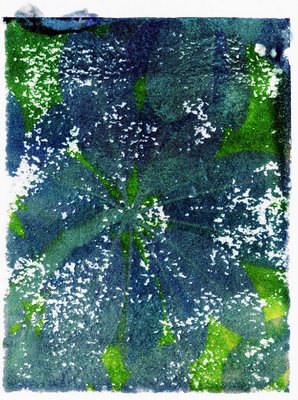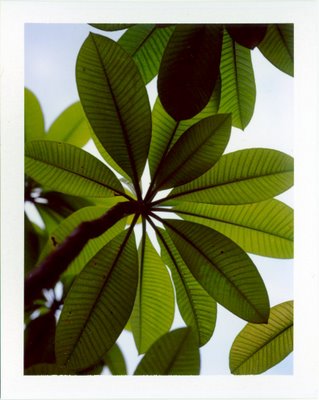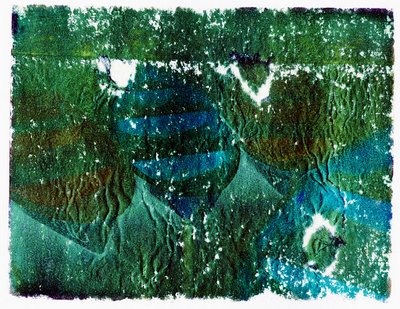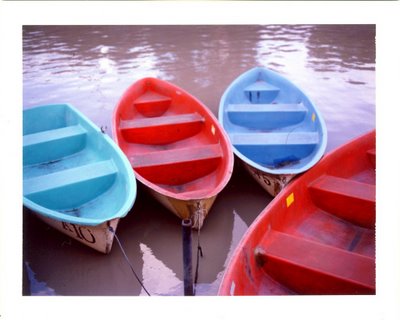Analog Picnic, Part 2: Peel-Apart Instant Film
I don't even know what to call this film. The box reads "10 instant color prints 8.5x10.8cm". Instant could also mean Instax , that I tested a few days ago in Santiphab Park. But peel-apart film is much more complex to use. You load it into a Polaroid back, then you pull out the pictures yourself, which is not easy to master. You need to pull at the right angle and at the right speed. Once your print is out of the back, you need to wait for it to develop and time it. You also need to know the ambient temperature, as it will affect development times. When the set time has run out, you peel the picture away from a gooey negative covered in toxic chemicals that you normaly throw away.
I tested this film at Chatuchak Park with Fuji FP-100C that Fuji gave me. You can't find Polaroid film in Thailand anymore and I'm not sure how bad the situation is abroad but instant film is definitely on the brink of extinction. This kind of film was extremely important to studio photographers before digital because it was the only way to get an idea of what your pictures would look like. It allowed you to test your light setup in particular. Photographers would just snap in a Polaroid back, shoot, and if they liked the result, pop in a film back and shoot the same thing over again. It also allowed the client to have a peek at what was going on and make dumb suggestions. Clients love digital because of that. They can see more, see it sooner, and see it more clearly. Unfortunately, the result for photographers is more dumb client suggestions.
Holding an instant print, I was struck by how close in size it is to Instax; but the colors somehow look richer and more velvety on the peel-apart. It also hit me why I shot Polaroids and slide for so long (yes I shot peel-apart not as proofs but as the final thing). I hated prints and couldn't understand why. I kept blaming the labs. The truth is slides, or reversal film, and instant film, have very high contrast. High-contrast is beautiful but very hard to handle. Expose for the sky and the landscape will be pitch black. Expose for the landscape, and the sky will be a big white slab. But when you do find a subject with low enough contrast, or somehow hit the right exposure, the results can be really beautiful. I always wondered if I was just being silly shooting peel-apart instant film but I can now see it made sense considering I didn't know how to make high-contrast prints from negatives.
Shooting these pictures was very nostalgic. This film is very expensive and might not be sold in the near-future. If I hadn't got these packs for free, I wouldn't be doing this. So I guess this is my farewell to instant film. I shot using this:
The Polaroid 600 SE is the best camera in the world to shoot peel-apart film. People somehow never mention it without using the word "tank" as if every other camera ever made was a piece of plastic junk compared to this beast. Polaroid made many other cameras that shot only peel-apart, and did this for years. They were all equipped with bellows and the nicer models--such as the 250 and 350 (automatic) or the highly desirable 180, 190, and 195 (manual)--were made of brushed steel. It was with 250's and 350's that I started taking Polaroids. I still have a whole bunch, all in perfect order despite the state I would often get them in.
The Polaroid 600 SE used to be worth a lot of money. I considered selling mine but I think prices have crashed recently with fears of instant film's future. It is still the best camera to instantly get prints without electricity. That may sound like a rare case scenario but I have a friend's father who is a very serious photographer and complained about not being able to give prints to people he met in remote locations (Kyrgyzistan was his last trip) because they had no e-mail or reliable address. He uses Hasselblads and unfortunately, a Polaroid back on a Hasselblad will only yield a 6x6 image that leaves much of the print's 8.5x10.8 surface unused.




I tested this film at Chatuchak Park with Fuji FP-100C that Fuji gave me. You can't find Polaroid film in Thailand anymore and I'm not sure how bad the situation is abroad but instant film is definitely on the brink of extinction. This kind of film was extremely important to studio photographers before digital because it was the only way to get an idea of what your pictures would look like. It allowed you to test your light setup in particular. Photographers would just snap in a Polaroid back, shoot, and if they liked the result, pop in a film back and shoot the same thing over again. It also allowed the client to have a peek at what was going on and make dumb suggestions. Clients love digital because of that. They can see more, see it sooner, and see it more clearly. Unfortunately, the result for photographers is more dumb client suggestions.
Holding an instant print, I was struck by how close in size it is to Instax; but the colors somehow look richer and more velvety on the peel-apart. It also hit me why I shot Polaroids and slide for so long (yes I shot peel-apart not as proofs but as the final thing). I hated prints and couldn't understand why. I kept blaming the labs. The truth is slides, or reversal film, and instant film, have very high contrast. High-contrast is beautiful but very hard to handle. Expose for the sky and the landscape will be pitch black. Expose for the landscape, and the sky will be a big white slab. But when you do find a subject with low enough contrast, or somehow hit the right exposure, the results can be really beautiful. I always wondered if I was just being silly shooting peel-apart instant film but I can now see it made sense considering I didn't know how to make high-contrast prints from negatives.
Shooting these pictures was very nostalgic. This film is very expensive and might not be sold in the near-future. If I hadn't got these packs for free, I wouldn't be doing this. So I guess this is my farewell to instant film. I shot using this:

The Polaroid 600 SE is the best camera in the world to shoot peel-apart film. People somehow never mention it without using the word "tank" as if every other camera ever made was a piece of plastic junk compared to this beast. Polaroid made many other cameras that shot only peel-apart, and did this for years. They were all equipped with bellows and the nicer models--such as the 250 and 350 (automatic) or the highly desirable 180, 190, and 195 (manual)--were made of brushed steel. It was with 250's and 350's that I started taking Polaroids. I still have a whole bunch, all in perfect order despite the state I would often get them in.
The Polaroid 600 SE used to be worth a lot of money. I considered selling mine but I think prices have crashed recently with fears of instant film's future. It is still the best camera to instantly get prints without electricity. That may sound like a rare case scenario but I have a friend's father who is a very serious photographer and complained about not being able to give prints to people he met in remote locations (Kyrgyzistan was his last trip) because they had no e-mail or reliable address. He uses Hasselblads and unfortunately, a Polaroid back on a Hasselblad will only yield a 6x6 image that leaves much of the print's 8.5x10.8 surface unused.




The negative prints you see above along with the normal prints were made by pressing onto a piece of paper the normaly discarded chemical-oozing negative that you peel-off the picture. The paper needs to be absorbant, not too glossy, but don't leave the negative on its surface too long or it will just stick to it. Contrast and detail being quite low on the paper-print, this trick works best with big clear shapes of highly-contrasting colors or luminosities.

0 Comments:
Post a Comment
<< Home